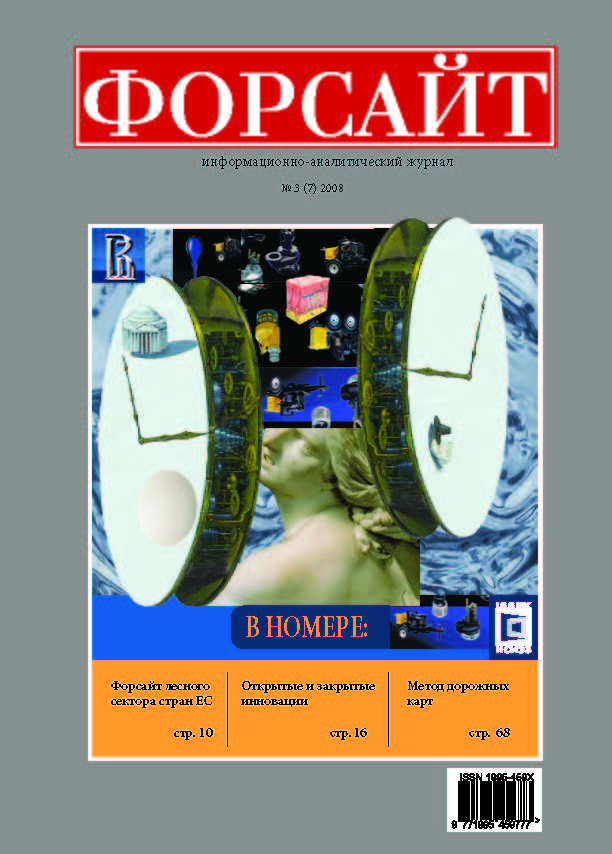Abstract
This paper aims at capturing trends in current inventive activities, based on an analysis of nanotechnology-related patents. The analysis addresses questions such as:
•What is the difference between nanotechnology and other conventional technologies? (Particularly in relation to their breadth, sectoral distribution of applicants and international collaboration in invention).
•What is the comparative strength of countries in nanotechnology? (Countries. share in patent applications).
•How do scientific and inventive activities interact in nanotechnology? (Measurement of the ratio of non-patent literature in citations).
•How fast has nanotechnology been evolving over time? (Measurement of time-lags between successive inventions).
References
Arundel A., Kable I. What Percentage of Innovations are Patented? Empirical Estimates for European Firms / Research Policy, 1998, v. 27, № 127, p. 141.
Binning G., Quate C.F., Gerber Ch. Atomic Force Microscope / Physical Review Letters, 1986, v. 56, № 9, р. 930-933.
Binning G., Rohrer H., Gerber Ch., Weibel E. Surface Studies by Scanning Tunneling Microscopy / Physical Review Letters, 1982, v. 49, №1, p. 57-61.
Feynman R.P. There's Plenty of Room at the Bottom / Annual Meeting of the American Physical Society at the California Institute of Technology, 1959.
Harhoff D., Narin F., Scherer F.M.,Vopel K. Citation Frequency and the Value of Patented Inventions / The Review of Economics and Statistics, 1999, v. 81, № 3, р. 511-515.
Harhoff D., Scherer F.M., Vopel K. Citations, Family Size, Opposition and the Value of Patent Rights / Research Policy, 2003, v. 32, p. 1343-1363.
Heinze T. Nanoscience and Nanotechnology in Europe: Analysis of Publications and Patent Applications including Comparisons with the United States / Nanotechnology Law & Business, 2004, v. 1, № 4, p. 427-445.
Henderson R., Jaffe A.B., Trajtenberg M. Universities as a Source of Commercial Technology: A Detailed Analysis of University Patenting, 1965-1988 / The Review of Economics and Statistics, 1998, v. 80, № 1, р. 119-127.
Huang Z., Chen H., Chen Z.K., Roco M.C. International Nanotechnology Development in 2003: Country, Institution, and Technology Field Analysis Based on USPTO Patent Database, 2004.
Igami M., Saka A. Capturing the Evolving Nature of Science, Development of New Scientific Indicators and Mapping of Science. STI Working Paper 2007/1. OECD Directorate for Science, Technology and Industry, 2007.
Iijima S. Helical Micro-tubules of Graphitic Carbon / Nature, 1991, №345, р. 56-58.
Jaffe A.B., Trajtenberg M. International Knowledge Flows: Evidence from Patent Citations / Economics of Innovation and New Technology, 1998, №8, р. 105-136.
Jaffe A.B., Trajtenberg M., Fogarty M.S. Knowledge Spillovers and Patent Citations: Evidence from a Survey of Inventors / The American Economic Review, 2000, v. 90, № 2, р. 215-218.
Kroto H.W., Heath J.R., O'Brien S.C., Curl R.F., Smalley R.E. C60: Buckminsterfullerene / Nature, 1985, № 318, p. 162-163.
Kubo R. Electronic Properties of Metallic Fine Particles / Journal of the Physical Society of Japan, 1962, v. 17, № 6, р. 975-986.
Lanjouw J.O., Schankerman M. The Quality of Ideas: Measuring Innovation with Multiple Indicators. NBER Working Paper №W7345, 1999.
Meyer M. Are Patenting Scientists the Better Scholars? An Exploratory Comparison of Inventor-authors with their Non-inventing Peers in Nano-science and Technology / Research Policy, 2006a, v. 35, p. 1646-1662.
Meyer M. What Do We Know about Innovation in Nanotechnology? Some Propositions about an Emerging Field between Hype and Pathdependency. Paper presented at SPRU 40th Anniversary Conference «The Future of Science, Technology and Innovation Policy», SPRU, Brighton, East Sussex, United Kingdom, 2006b.
Meyer M. What is Special about Patent Citations? Differences between Scientific and Patent Citations / Scientometrics, 2000, v. 49, №1, р. 93-123.
Narin F., Hamilton K.S., Olivastro D. The Increasing Linkage between U.S. Technology and Public Science / Research Policy, 1997, v. 26, p. 317-330.
OECD. Compendium of Patent Statistics. Paris: OECD, 2006.
Scheu M., Veefkind V., Verbandt Y., Molina Galan E., Absalom R., Fцrster W. Mapping nanotechnology patents: The EPO approach / World Patent Information, 2006, v. 28, p. 204-211.
Small H., Sweeney E. Clustering the Science Citation Index using Co-citations. I. A Comparison of Methods / Scientometrics, 1985a, v. 7, p. 3-6, p. 391-409.
Small H., Sweeney E., Greenlee E. Clustering the Science Citation Index using Co-citations. II. Mapping Science / Scientometrics, 1985b, v. 8, p. 5-6, p. 321-340.
Webb C., Dernis H., Harhoff D., Hoisl K. Analysing European and International Patent Citations: A Set of EPO Patent Database Building Blocks. STI Working Paper 2005/9. OECD Directorate for Science, Technology and Industry, 2005.
Zhou P., Leydesdorff L. The Emergence of China as a Leading Nation in Science / Research Policy, 2006, v. 35, p. 83-104.
Zucker L.G., Darby M.R., Furner J., Liu R.C., Ma H. Minerva Unbound: Knowledge Stocks, Knowledge Flows and New Knowledge Production. NBER Working Paper №12669, 2006.
von Wartburg I., Teichert T., Rost K. Inventive Progress Measured by Multi-stage Patent Citation Analysis / Research Policy, 2005, v. 34, p. 1591-1607.

This work is licensed under a Creative Commons Attribution 4.0 International License.

